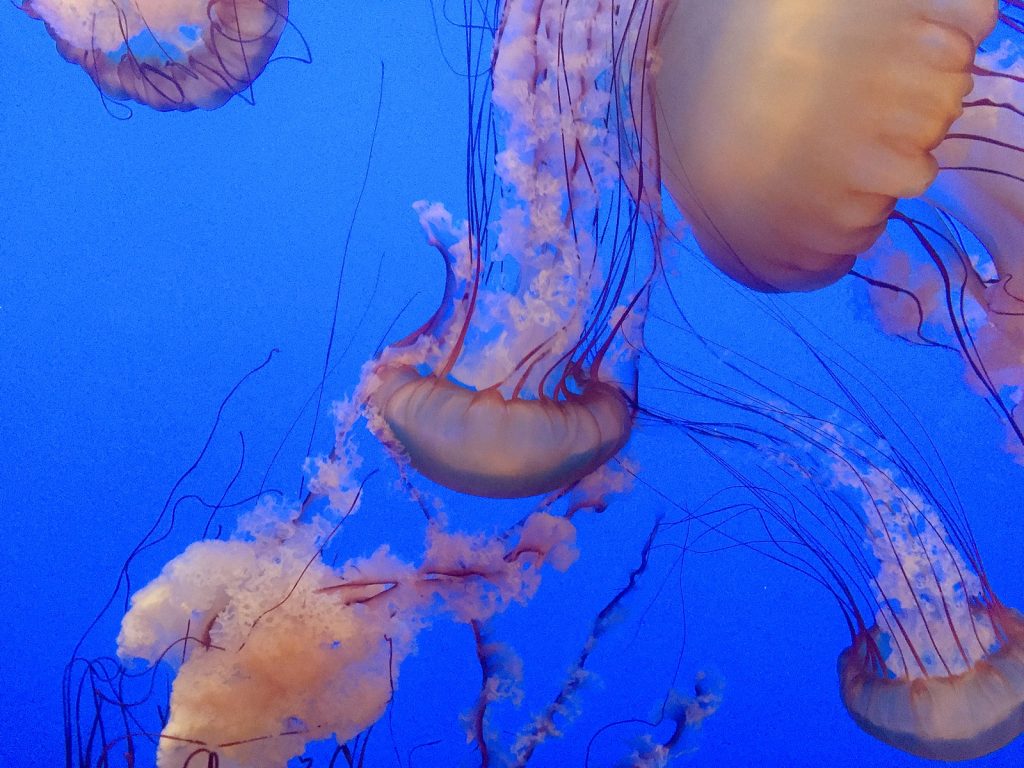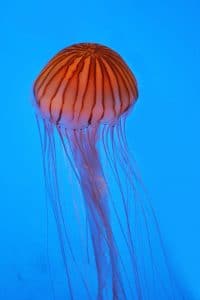By Susan D’Agostino | October 28, 2021

Sea nettle jellyfish swimming at Monterey Bay Aquarium in Monterey, CA. Credit: Photollama. Accessed via Wikimedia Commons. CC BY-SA 4.0.
Scotland’s only working nuclear power plant at Torness shut down in an emergency procedure when jellyfish clogged the sea water-cooling intake pipes at the plant, according to the Scotland Herald this week. Without access to cool water, a nuclear power plant risks overheating, with potentially disastrous results (see: Fukushima). The intake pipes can also be damaged, which disrupts power generation. And ocean life that gets sucked into a power plant’s intake pipes risks death.
Scotland’s only working nuclear power plant at Torness shut down in an emergency procedure when jellyfish clogged the sea water-cooling intake pipes at the plant, according to the Scotland Herald this week. Without access to cool water, a nuclear power plant risks overheating, with potentially disastrous results (see: Fukushima). The intake pipes can also be damaged, which disrupts power generation. And ocean life that gets sucked into a power plant’s intake pipes risks death.

Pacific sea nettle jellyfish. Credit: Jachintapasca. Accessed via Wikimedia Commons. CC BY-SA 4.0.
The threat these gelatinous, pulsating, umbrella-shaped marine animals pose to nuclear power plants is neither new nor unknown. (Indeed, the Bulletin reported on this threat in 2015.) Nuclear power plant closures—even temporary ones—are expensive. To protect marine life and avert power plant closures, scientists are exploring early warning system options. For example, researchers at Cranfield University in the United Kingdom launched a project earlier this year to determine whether drones may be used to provide estimates of jellyfish locations, amounts, and density.
“The successful operation of [beyond visual line of sight drones] will enable us to detect threats from marine ingress at an earlier state and prevent disruption to the power plant,” Monica Rivas Casado, a senior lecturer in environmental monitoring at Cranfield, said. In the United Kingdom, 20 percent of electricity is nuclear, a percentage roughly equaled in the United States, compared with approximately 10 percent globally.
Blooms of translucent jellyfish with their trailing, stinging tentacles are sometimes described as “invasions” because they often emerge en masse in way that appears sudden. Still, determined observers may find early clues of a jellyfish bloom. Spotting jellyfish swarms by way of drones requires balancing recognition accuracy with recognition speed—at least if the goal is to take preventative action to avoid nuclear power plant disruption. Scientists have been at work developing algorithms that foster this balance, including one study that delivered results within a desirable timeframe and over 90 percent accuracy.
The threat these gelatinous, pulsating, umbrella-shaped marine animals pose to nuclear power plants is neither new nor unknown. (Indeed, the Bulletin reported on this threat in 2015.) Nuclear power plant closures—even temporary ones—are expensive. To protect marine life and avert power plant closures, scientists are exploring early warning system options. For example, researchers at Cranfield University in the United Kingdom launched a project earlier this year to determine whether drones may be used to provide estimates of jellyfish locations, amounts, and density.
“The successful operation of [beyond visual line of sight drones] will enable us to detect threats from marine ingress at an earlier state and prevent disruption to the power plant,” Monica Rivas Casado, a senior lecturer in environmental monitoring at Cranfield, said. In the United Kingdom, 20 percent of electricity is nuclear, a percentage roughly equaled in the United States, compared with approximately 10 percent globally.
Blooms of translucent jellyfish with their trailing, stinging tentacles are sometimes described as “invasions” because they often emerge en masse in way that appears sudden. Still, determined observers may find early clues of a jellyfish bloom. Spotting jellyfish swarms by way of drones requires balancing recognition accuracy with recognition speed—at least if the goal is to take preventative action to avoid nuclear power plant disruption. Scientists have been at work developing algorithms that foster this balance, including one study that delivered results within a desirable timeframe and over 90 percent accuracy.
RELATED:
Houston, are we going to have a problem with space nuclear power?
In another early-detection effort, scientists have investigated the potential for acoustic characteristics of these sea creatures to detect their numbers, density, and threat level. The creatures’ underwater undulations create sounds—known as “echo energy” or “acoustic scatterings”—that give them away, as long as humans are willing to listen.
The clash between gelatinous jellyfish and hulking nuclear power plants has a long history. These spineless, brainless, bloodless creatures shut down the Torness nuclear power plant in 2011 at a cost of approximately $1.5 million per day, according to one estimate. Swarms of these invertebrates have also been responsible for nuclear power plant shutdowns in Israel, Japan, the United States, the Philippines, South Korea, and Sweden.
Northern sea nettle. Credit: Joe Ravi. Wikimedia Commons. CC BY-SA 3.0.
Humans have unwittingly nurtured the adversarial relationship between jellyfish and nuclear power plants. That is, human-induced climate change has raised ocean water temperatures, setting conditions for larger-than-usual jellyfish populations. Further, the relatively warm water near nuclear power plant discharge outlets may attract jellyfish swarms, according to one study. Also, pollution has lowered oxygen levels in sea water, which jellyfish tolerate more than other marine animals, leading to their proliferation.
Some look at jellyfish and see elegant ballerinas of the sea, while others view them as pests. Either way, they are nothing if not resilient. Jellyfish are 95 percent water, drift in topical waters and the Arctic Ocean, and thrive in the ocean’s bottom as well as on its surface. Nuclear power plant operators might take note: Older-than-dinosaur jellyfish are likely here to stay.
Humans have unwittingly nurtured the adversarial relationship between jellyfish and nuclear power plants. That is, human-induced climate change has raised ocean water temperatures, setting conditions for larger-than-usual jellyfish populations. Further, the relatively warm water near nuclear power plant discharge outlets may attract jellyfish swarms, according to one study. Also, pollution has lowered oxygen levels in sea water, which jellyfish tolerate more than other marine animals, leading to their proliferation.
Some look at jellyfish and see elegant ballerinas of the sea, while others view them as pests. Either way, they are nothing if not resilient. Jellyfish are 95 percent water, drift in topical waters and the Arctic Ocean, and thrive in the ocean’s bottom as well as on its surface. Nuclear power plant operators might take note: Older-than-dinosaur jellyfish are likely here to stay.

No comments:
Post a Comment